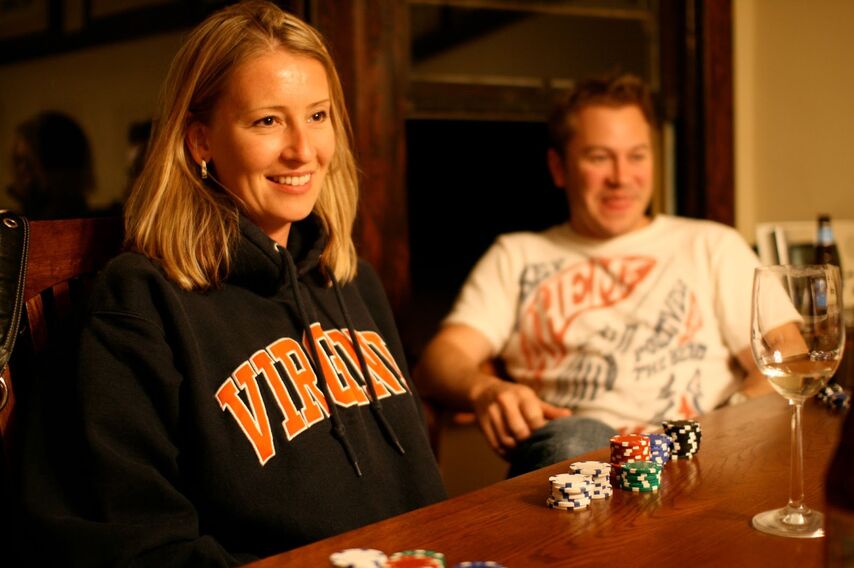Indian Poker is a game with many names, including Blind Man’s Bluff, Squaw Poker, Oklahoma Forehead, and Indian Head. It’s best to play the game with 2-8 players around a table, with a deck of cards and poker chips.
In Texas hold ‘em, you see two private cards, but in Indian Poker, you get one card that you cannot see. Everyone at the table gets to see your card and you get to see theirs, but you won’t know what you’ve got until the end. The aim of the game is simple; the player with the highest card wins, but you won’t know how strong your card is until the end.
If you’re looking for a simple poker game, this is it. You can learn the rules quickly and you’re guaranteed to laugh a lot playing this game. Let’s go over the rules and basic strategy of Indian Poker.

The Basic Rules of Indian Poker [+ What You Need to Play]
A 52-card deck and poker chips are the only supplies you need to play Indian Poker. Usually, friends play Indian Poker for real money, but small stakes.
Here’s how to play Indian Poker:
- Choose a dealer. There is no real advantage or disadvantage to being the dealer, except that you’ll need to give a card to each player at the start of each new game. The dealer should change every time a hand finishes.
- Place the antes in the pot. Before players get their cards, everyone needs to place an ante into the pot. The ante is a very small mandatory bet that gets the action going. In the standard version of Indian Poker, there aren’t big blinds like in other types of poker.
Ante Size: Make sure that the ante is a small percentage of each player’s total chips or around 1-3%.
- Deal one card face-down to each player. When the dealer says so, each player slowly moves the card to their forehead – making sure they don’t get a glimpse of their card. Everyone must hold this card to their forehead without seeing their cards. This is very important in Indian Poker; we must not know our card and we can only see our opponents’ cards.
- Begin the betting round. Starting from the dealer, players can check, call, raise, and fold. It’s common to see lots of small raises as players try to figure out how strong their hand is.
- Showdown time! There’s usually one betting round in Indian Poker. Once all bets have been matched, it’s time for a showdown. All of the players who didn’t fold need to compare their cards to decide the winner. The player with the strongest card takes all of the chips in the pot.
The card ranks are very simple in Indian Poker. An Ace is the best possible card, then the King, Queen, Jack, ten, and so on. In some versions of Indian Poker, players choose to give a rank to the card suits.
Note: Some people stick the cards to their forehead with a small piece of tape or just hold it there with their hands. Historically, players would lick a finger and use the moisture to stick the card to their skin. Be careful with that method; if the card falls, it could ruin everything!
- Increased first deposit bonus
- Increased rakeback and reloads
- Help with deposits and cashouts
- Access to private freerolls
- Round-the-clock support
Indian Poker Strategy is All About Psychology and Instinct
How can we call, bet, and raise without knowing our card? The strategy for Indian Poker seems confusing at first, but there’s a trick to it.
You need information from your opponents to guess the strength of your card. At the same time, they’ll be studying your betting and scrutinizing your poker face too, trying to guess what card they have.

Follow the gaze of your opponents. If someone across from you starts giggling as they see your card, it probably means you have a very weak card. Use body language and facial expressions to try and work out what card is on your forehead. The more players you have around the table, the easier this will be.
Use the information available to you, like your opponents’ willingness to call bets. If opponents fold to your bets, you can guess that you have a card of some strength, like a 9, 10, or higher. If your opponents are eager to raise your bets, you might have a low card like 2, 3, 4, or something similar.
The more you get to know the other players, the easier this game becomes. The more time you put towards playing poker the better, and freerolls give you a way to get practice without having to pay for it. Some poker sites like 888poker have more freerolls than others, with prize pools ranging from $50 guaranteed to $10,000 guaranteed.
Can You Play Indian Poker Online?
Unfortunately, major poker sites probably won’t be offering Indian Poker anytime soon. This game is best played in the living room or around the kitchen table at home. Texas hold ‘em and Omaha are the two most popular poker games online, making up most of the traffic on sites.

Whatever format of poker you play, there’s a very good chance that PokerStars has the online version. There are 17 different kinds of poker to play on their site, which you can download for Apple or Windows PCs and all mobile devices. Aside from the most popular formats we mentioned, there’s also Razz, Stud, 5-Card Draw, Omaha Hi/Lo, and even Badugi. PokerStars is one of the biggest sites, so their cash games and tournaments are always full of players.
One of the stand-out features at PokerStars are the private Home Games that members can set up. You can use their top-of-the-line software to organize cash games and tournaments, then invite as many friends as you can. These Home Games can be setup with Play Money if you don’t feel like putting real money on the line.

























